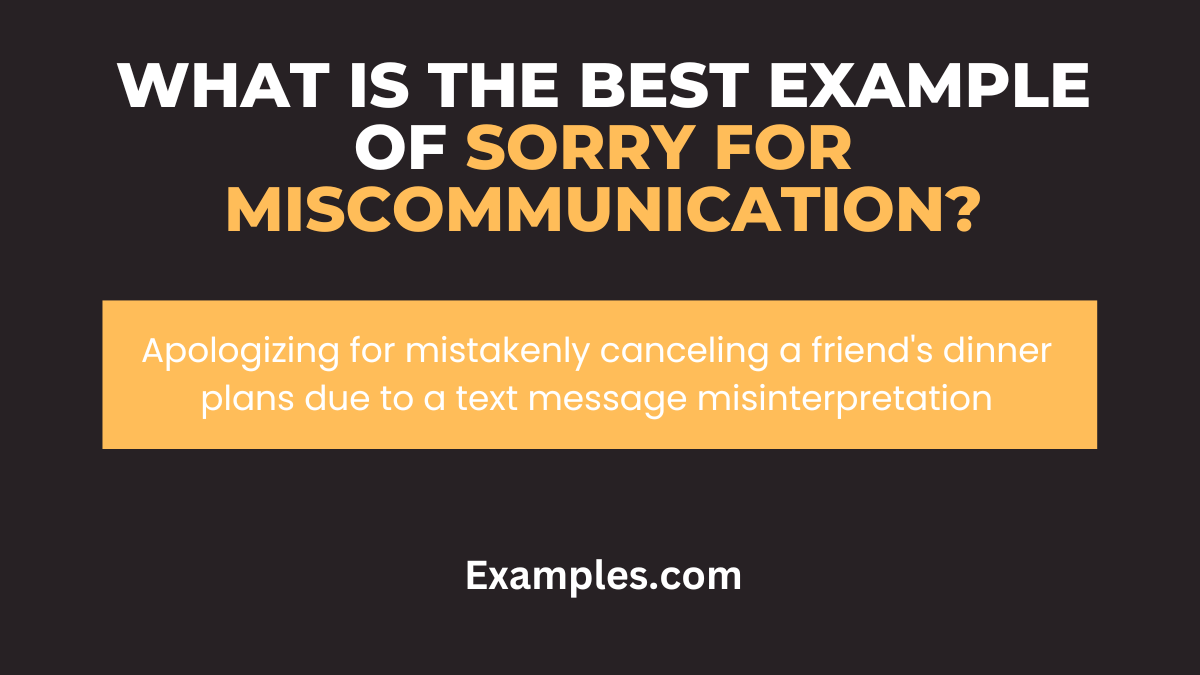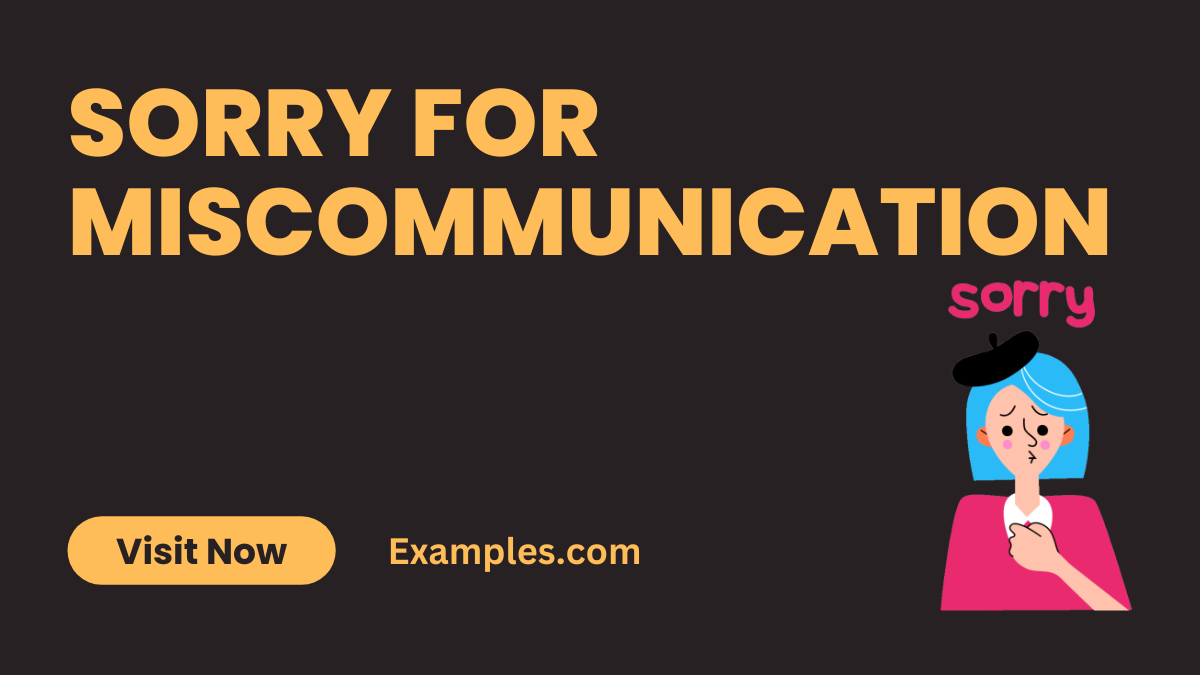29+ Sorry for Miscommunication Examples
The phrase “Sorry for Miscommunication” is a powerful tool for mending misunderstandings and fostering better relationships. Miscommunications are common in both personal and professional settings, often leading to unnecessary complications. This guide provides valuable insights into the nuances of apologizing for miscommunication, offering practical tips for effectively conveying your message. Understanding the importance of clarity, empathy, and active listening can transform your interactions, making “Sorry for Miscommunication” a phrase that not only resolves conflicts but also strengthens connections.
What is the Best Example of Sorry for Miscommunication?

A classic example is in the workplace, where a team member misinterprets an email, leading to a project delay. Acknowledging the error with a ‘Sorry for Miscommunication’ helps clear the air, promotes mutual understanding, and guides the team back on track.
30 Examples of Sorry for Miscommunication

Apologizing for miscommunication is crucial in maintaining healthy relationships and effective communication. It involves acknowledging misunderstandings, clarifying intentions, and seeking mutual understanding. Whether in personal interactions, workplace dynamics, or cross-cultural exchanges, a sincere apology can bridge gaps caused by miscommunication. This approach not only resolves conflicts but also strengthens bonds and trust between individuals. Learning to effectively say “sorry for miscommunication” is a vital skill in today’s interconnected world, where messages can easily become distorted.
- Email Misinterpretation: “I apologize for any confusion caused by my last email. I meant to suggest a team meeting next week, not a deadline change.”
- Texting Tone Misread: “Sorry if my text came across as harsh. I was trying to be concise, not curt.”
- Cultural Misunderstanding in Business: “My apologies for the miscommunication. I now understand that in your culture, my approach might have been too direct.”
- Project Specifications Mix-up: “I apologize for the confusion about the project requirements. I’ll clarify the specifications.”
- Misheard Instructions in Healthcare: “I’m sorry for the misunderstanding about the medication dosage. Let me re-explain it for clarity.”
- Workplace Deadline Confusion: “I apologize for any miscommunication regarding the project deadline. I meant next Friday, not this one.”
- Relationship Misinterpretation: “Sorry, I misunderstood what you were saying. Can we talk it out?”
- Meeting Time Mix-up: “My apologies for the confusion about the meeting time. I’ll send a calendar invite to avoid future mix-ups.”
- Client Requirement Misunderstanding: “I apologize for not fully understanding your requirements. Let’s revisit them to ensure we’re on the same page.”
- Instruction Miscommunication in School: “I’m sorry for the confusion about the homework. Let me explain it again.”
- Social Media Post Misinterpretation: “Sorry if my post was unclear. I meant to highlight the positive aspects of the event.”
- Marriage Misunderstanding: “I apologize for not understanding your point of view earlier. Let’s discuss it more.”
- Texting Abbreviation Confusion: “Sorry for the miscommunication. ‘BRB’ meant ‘be right back,’ not ‘busy right now.'”
- Family Plan Miscommunication: “I apologize for the confusion about the family dinner plans. I’ll make sure everyone is updated.”
- Language Barrier in Cross-Cultural Interaction: “Sorry for any misunderstanding due to my limited language skills. I appreciate your patience.”
- Misinterpreted Feedback in the Workplace: “I apologize if my feedback seemed critical. I intended it to be constructive.”
- Nursing Instruction Ambiguity: “I’m sorry for any confusion with the care instructions. Let’s go over them again.”
- Generational Miscommunication in Family: “I apologize for the mix-up. I didn’t realize the term meant something different to your generation.”
- Email Tone Misinterpretation: “I’m sorry if my email tone seemed abrupt. I’ll make sure to be more clear in the future.”
- Friends’ Plans Misunderstanding: “Sorry for the mix-up about our plans. I misunderstood the day we agreed upon.”
How to Say Sorry for Miscommunication?
- Acknowledge the Misunderstanding: Begin by clearly acknowledging that there was a miscommunication.
- Express Sincerity: Convey your apology sincerely, showing genuine remorse.
- Describe the Situation: Briefly explain the context of the miscommunication to clarify your perspective.
- Take Responsibility: Accept responsibility for your part in the miscommunication.
- Offer a Solution: Propose ways to rectify the situation or prevent similar issues in the future.
- Ask for Forgiveness: Politely ask for forgiveness to mend the relationship.
- Maintain Open Communication: Encourage open and clear communication moving forward.
- Follow-up Actions: Demonstrate through actions that you are committed to better communication.
Sorry for Miscommunication Message
- Begin with a Direct Apology: Start your message with a clear “I’m sorry for the miscommunication…”
- Personalize the Message: Tailor the apology to the person and situation involved.
- Explain Without Excuses: Give a brief explanation without making excuses.
- Acknowledge the Impact: Recognize how the miscommunication may have affected the other person.
- Express Willingness to Correct: Show your willingness to make things right.
- Keep it Concise and Clear: Ensure your message is straightforward and to the point.
- Use a Respectful Tone: Maintain a tone of respect and understanding throughout.
- End on a Positive Note: Conclude with a positive remark or a hopeful look towards future interactions.
Sorry for Miscommunication at the Workplace
- Immediate Acknowledgment: Address the miscommunication as soon as you become aware of it.
- Professional Tone: Keep your apology professional and respectful.
- Discuss Impact on Work: Acknowledge how the miscommunication might have impacted work or colleagues.
- Offer to Rectify: Propose concrete steps to fix any issues caused.
- Seek Feedback: Ask for input on how to improve communication in the future.
- Document Your Apology: Depending on the situation, a written apology might be appropriate.
- Reiterate Commitment to Team Goals: Emphasize your dedication to teamwork and collaboration.
- Learn from the Experience: Use this as a learning opportunity to enhance workplace communication skills.
Acknowledging and rectifying miscommunication is crucial in fostering effective relationships. By following the guide and tips provided in this article, you can learn how to apologize sincerely for misunderstandings. Remember to communicate openly, take responsibility, and seek clarity to mend any communication gaps, ensuring smoother interactions and stronger connections with others.



